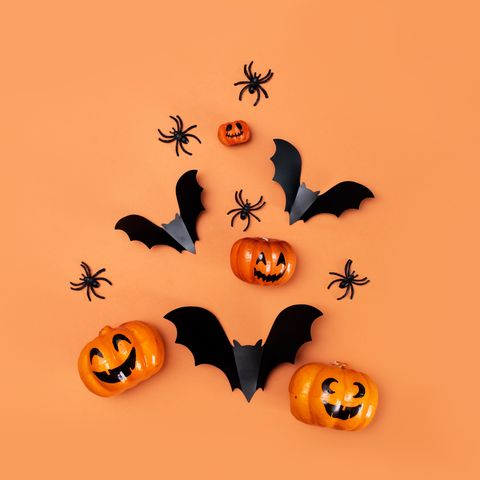What Other Colors Do Pumpkins Come in Besides Orange
Orange and black are so strongly associated with Halloween that wearing the two colors together outside of the month of October is practically taboo. Because of their connection to Halloween, many people also associate the festive hues with all things spooky. Still, the majority of people have no idea about the history of Halloween, or how its famous color combination came to be.
According to History.com, although the beginnings of Halloween stem from the people who inhabited a territory spanning parts of modern-day France, Ireland, and the United Kingdom (known as the Celts), these people didn't necessarily decorate with black and orange to mark the occasion. At least not right away.
Thousands of years ago, the Celts' calendar year began not on January 1, but on November 1. This date coincided with the end of harvest season and the beginning of winter. As the History.com article explains, the Celts believed the day before November 1 was the time of year when the spirits of the departed returned and allowed priests to make accurate predictions about the future, especially in regard to future crops and nature. To celebrate the day (known as Samhain to the Celts), people would wear costumes, make sacrifices to the dead, and build bonfires. In other words: Before October 31 was known for candy and pet costumes, it was a slightly different type of celebration (but a celebration all the same – and a spooky one at that).
This content is imported from {embed-name}. You may be able to find the same content in another format, or you may be able to find more information, at their web site.
As a House Beautiful article explains, black and orange were deliberately chosen as Halloween colors because of the fall-winter connection the day represents. Orange symbolizes the warmth of autumn and the last of harvest season, while black represents the cold, dark, and long winter.

Kseniya Ovchinnikova
Black
While some speculate that people gravitated toward wearing black because it represents the darkness and cold of winter, there's another option to consider, too. Black is also, conveniently, associated with death. Given that Samhain was all about the return of the departed, this makes sense. The Celts relished the opportunity for contact with their departed ancestors, so black was a natural choice to represent the temporarily open doors of communication between the dead and the living.
Orange
I know what you're thinking: Pumpkins. And while that would be the very obvious origin story for Halloween's use of the color orange, you'd be wrong. In fact, pumpkins were not even a thing in the earliest of October 31 celebrations by the Celts. Why? They originated in North America, where All Hallow's Eve wasn't celebrated until the 1800s. Interestingly though, lantern-carving (Jack-o'-Lantern, anyone?) did originate in Ireland, where they would shape vegetables like potatoes and turnips to create lanterns for Stingy Jack.
Following the potato famine of 1846, an influx of Irish immigrants began using pumpkins instead, solidifying the tradition in American culture. Maybe this only added to the popularity of orange during the October 31 holiday, but it was likely a feature of Halloween long before the 1800s. Given that orange is such a familiar hue of fall, when leaves exhibit shades of orange and red not typically seen in nature during the rest of the year, this makes sense. Remembering the bonfires of the Celts, it's also a tone associated with fire.
The combination of fall and winter themes may not be something you've thought about frequently when it comes to Halloween, but when you consider where the holiday falls on the calendar year, it makes perfect sense. After all, that's what Halloween is all about — the coziness and warmth of fall combined with the spooky darkness of a cold, dark winter. But there's one more color to consider: Purple.

solarseven
Purple
Haven't thought of purple as a Halloween color? Look for it next time you stroll through your local party store's holiday decoration or costume aisles. It's not as frequently used as orange and black, but it's certainly present. The assumption with purple is that it's a Halloween hue because of its association with all things spiritual and mystical, so perhaps it's purple's connection to religious rituals (its often worn by priests) that ties it to the ancient history of October 31. Or perhaps it's related to a more modern phenomenon: A Scientific American article posits that since research shows purple is a color today's consumers often relate to children and laughter, "the introduction of purple to Halloween may be tied to the evolution of the commercialism of the holiday."
This content is created and maintained by a third party, and imported onto this page to help users provide their email addresses. You may be able to find more information about this and similar content at piano.io
What Other Colors Do Pumpkins Come in Besides Orange
Source: https://www.womansday.com/life/a56608/black-and-orange-halloween-colors/